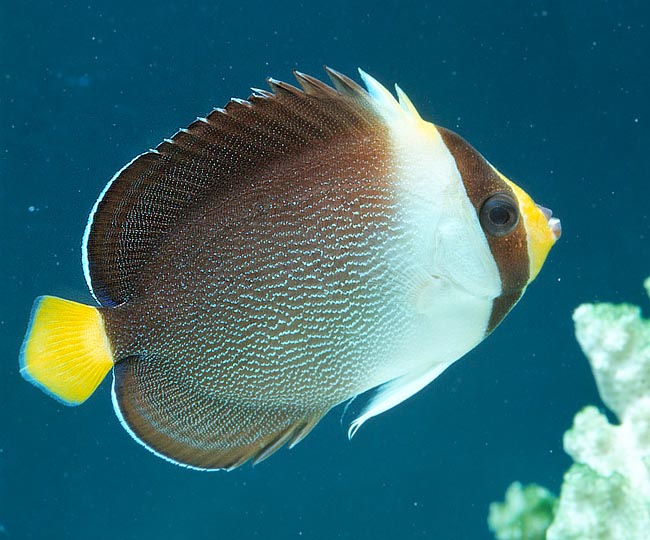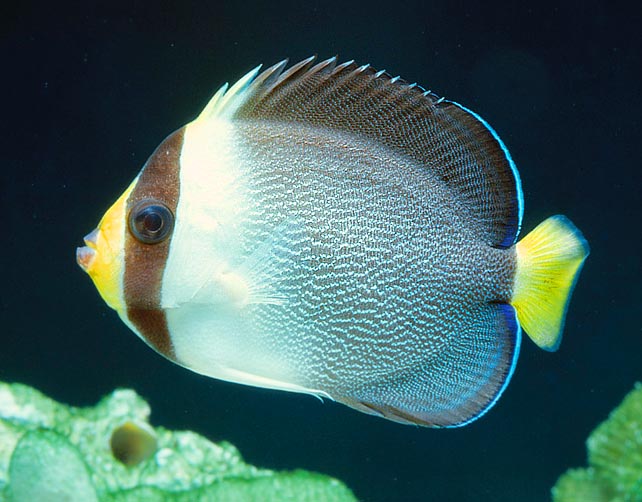Family : Pomacanthidae

Text © Giuseppe Mazza

English translation by Mario Beltramini

Chaetodontoplus mesoleucus seems a butterflyfish, but belongs to the angelfishes © Giuseppe Mazza
The very unusual Vermiculated angelfish (Chaetodontoplus mesoleucus Bloch, 1787) belongs to the class of the Actinopterygii, the ray-finned fishes, to the order of Perciformes and to the family of Pomacanthidae.
The name of the genus comes from the Greek “chaite” = hair and “odous” = tooth, the well known roots of the genus Chaetodon, the fishes with the “bristle-shaped teeth”, with the addition of “oplon” = weapon, with allusion to the spine on the preoperculum. It is, in short, an “armed “ Chaetodon, but not a butterflyfish, seen that it belongs to the family of the Pomacanthids, commonly called angelfishes.
The name of the species “mesoleucos” comes from “mesos” = middle and “leykos” = white, with reference to the big central spot on the body.
Zoogeography
It is mainly present in the tropical waters of the Pacific Ocean, but also on the eastern coasts of the Indian Ocean.
As a matter of fact, we find it, just to give an idea, in Sri Lanka, the Andaman Islands, Thailand, Malaysia, Singapore, Australia, Indonesia, New Guinea, Philippines, Taiwan, Vietnam, and China up to southern Japan. Eastwards, it stops at the Solomon Islands.
Ecology-Habitat
It lives in the madreporic formations up to 20 m of depth.

It eats sponges, ascidians and filamentous seaweeds. The populations are stable © Giuseppe Mazza
Morfo-physiology
The vermiculated angelfish does not exceed the 18 cm. its body is flat, more or less oval, and, at first sight, it seems a butterflyfish, as anyway states the root of the genus, but the spine at the base of the preoperculum, visible also in these pictures, makes the difference. Furthermore, the snout is quite different.
The dorsal fin has 12 spiny rays and 17-18 soft; the anal has 3 spiny rays and 17-18 soft; the ventral and the pectoral ones are unarmed and the caudal is more or less rounded.
The extremity of the head is yellow like the tail, just to confuse the ideas to the aggressors, and the eye, as often happens, is masked by a vertical dark band. Then a white zone follows, which is the one who has given the name to the species, and a vast dark area arabesqued by white small traits.
The edge of the dorsal, anal and caudal fins is bluish.
In some individuals, the tail is grey, and some hypothesize the presence of another species.
Ethology-Reproductive Biology
The vermiculated angelfish lives solitary, in pair or in small schools nourishing of sponges, ascidians and filamentous seaweeds. After the fecundation, the eggs are entrusted to the currents.
Even if fished for the aquaria market, its populations are presently stable thanks to the varied diet and to the fact that they may double in less than 15 months. The vulnerability index is therefore rather low: 25 per 100.
Synonyms
Chaetodon mesoleucus Bloch, 1787.
→ For general information about FISH please click here.
→ For general information about BONY FISH please click here
→ For general information about CARTILAGINOUS FISH please click here.
→ To appreciate the BIODIVERSITY of BONY FISH please click here.
→ To appreciate the BIODIVERSITY of CARTILAGINOUS FISH please click here.
